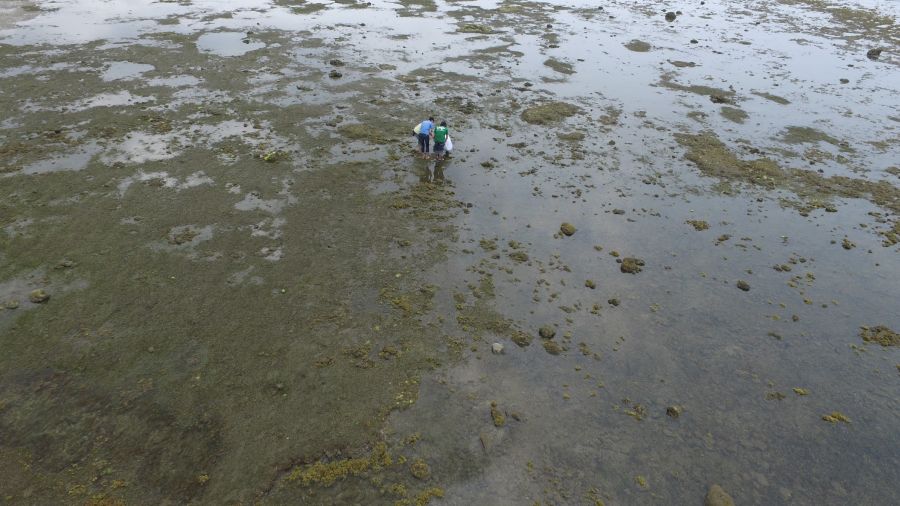生態農業:氣候變遷下以自然為本之濕地碳匯復育策略【生命科學系/林幸助特聘教授】
| 論文篇名 | 英文:High-resolution mapping of seagrass biomass dynamics suggests differential response of seagrasses to fluctuating environments 中文:海草生物量動態的高解析度繪圖顯示海草對變動環境的反應不同 |
| 期刊名稱 | Diversity |
| 發表年份,卷數,起迄頁數 | 2022, 14, 999 |
| 作者 | Chen, Kuan-Yu; Lin, Hsing-Juh(林幸助)* |
| DOI | 10.3390/d14110999 |
| 中文摘要 | 海草床是主要的藍碳生態系統。氣候變化相關因素可能會改變海草群落並影響碳吸存能力。為探究暖化、降雨量和/或海平面上升對海草的可能影響,對包括演替末期泰來草和演替早期單脈二藥草在內的淺海草床的空間和季節動態進行監測。高解析度海草生物量動態測繪顯示,泰來草是研究點全年的優勢種,較大型海草佔據空間的效率高於較小型海草。 兩個物種在低高程地點的空間佔用效率高於高高程地點。在低高程地區,生長較快的單脈二藥草的優勢正在增加,而泰來草的優勢正在下降。這顯示海草床的固碳能力將下降,因為泰來草能夠在沉積物中儲存更多的碳。然而,在高高程地區,兩個物種的分佈是不同的,並顯示出明顯的季節性演替。在雨季,單脈二藥草的優勢地位向較淺的水域移動,然後在旱季時移回較深的水域。此結果顯示,淺海域海草優勢轉移可能涉及4種機制:(1)低高程地區較深的水域或雨季較高的降雨量可能降低低潮時單脈二藥草的乾旱脅迫,增強其競爭力;(2)雨季降雨量增加對陸原營養的沖刷可能刺激單脈二藥草生長 ;(3)在高高程地區,旱季較快的流速和頻繁的沉積物擾動可能制約了單脈二藥草向淺水域的擴張;(4)高高程地區較快的流速可能降低附生藻類過度生長對泰來草的影響,因此維持泰來草的優勢度。我們的研究結果顯示,在未來幾十年中,海草不一定會以同樣的方式對環境做出反應。 |
| 英文摘要 | Seagrass beds are major blue carbon ecosystems. Climate change-associated factors may change the seagrass community and affect the capacity of carbon sequestration. To explore the possible effects of warming, higher precipitation levels and/or sea level rise on seagrasses, the spatial and seasonal dynamics in shallow seagrass beds comprising the late-successional seagrass Thalassia hemprichii and the early-successional seagrass Halodule uninervis were tracked. The high-resolution mapping of seagrass biomass dynamics showed that T. hemprichii was the dominant species in the study sites year round, as the space occupation by the larger seagrass T. hemprichii was more efficient than that by the smaller seagrass H. uninervis. The space occupation by both species in the low-elevation site was more efficient than in the high-elevation site. In the low-elevation site, while the dominance of the faster growing seagrass H. uninervis was increasing, the dominance of T. hemprichii was decreasing. This suggested that the carbon sequestration capacity of the seagrass beds will decrease, as T. hemprichii was capable of storing more carbon in the sediments. In the high-elevation site, however, the distribution of both species was distinct and showed a clear seasonal succession. The dominance of H. uninervis moved to shallower water in the wet season and then moved back to deeper water in the dry season. Our observations suggested that four possible mechanisms might be involved in the dominance shift in the shallow seagrass beds: (1) the deeper water in the low-elevation site or the higher precipitation levels in the wet season might reduce the drought stress of H. uninervis at low tide and enhance the competition of H. uninervis over T. hemprichii; (2) the growth of H. uninervis might be stimulated more by the flushing of land-based nutrients caused by the higher precipitation rates in the wet season; (3) in the high-elevation site, the faster flow velocity and frequently disturbed sediments in the dry season might constrain the further expansion of H. uninervis to shallower water; (4) the faster flow velocity in the high-elevation site might reduce the impacts of periphyton overgrowth on T. hemprichii and maintain the dominance of T. hemprichii in the community. Our results suggest seagrasses will not necessarily respond to fluctuating environments in the same way in the coming decades. |
| 發表成果與本中心研究主題相關性 | 氣候變遷對濕地碳匯之影響 |







